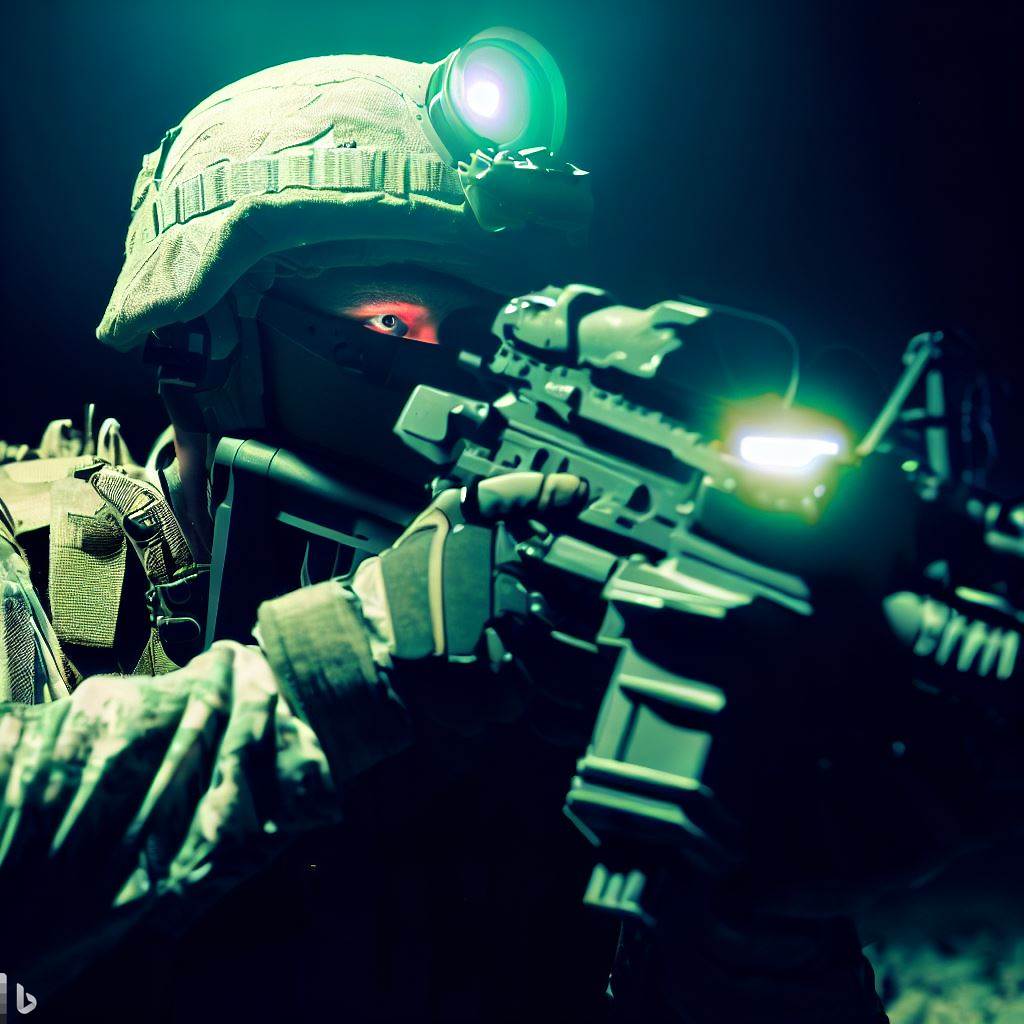

Good day! Today, we will be delving into the fascinating realm of night vision technology and exploring what the US Army utilizes to enhance its effectiveness in low-light conditions. Join us as we uncover and shed light on the innovative tools and techniques employed by the US Army to gain a tactical advantage in the dark.
Introduction
Night vision technology is a crucial component of modern military operations, allowing soldiers to see clearly in low-light or zero-light conditions. This technology has revolutionized warfare, providing a significant advantage to military forces by enabling them to operate effectively during nighttime operations.
In this article, we will explore the different generations of night vision technology, such as the 1st, 2nd, 3rd, and 4th generations, and dive into the various night vision systems used by the US Army and What The US Army uses for Night Vision.
Generation Of Night Vision Technology
1st Generation
The 1st generation of night vision technology was introduced during the Vietnam War and marked a significant advancement in military capabilities. These early systems used ambient light to amplify the available light and produce a visible image.
While they were limited in terms of image quality and performance, they provided soldiers with a considerable advantage in low-light conditions.
2nd Generation
With the 2nd generation of night vision technology, improvements were made to image quality and overall performance. These systems utilized a microchannel plate (MCP) to enhance the amplification of light, resulting in a clearer and sharper image.
Soldiers equipped with 2nd generation night vision devices experienced improved visibility during nighttime operations, leading to enhanced situational awareness.
3rd Generation
The 3rd generation of night vision technology represented a significant leap forward in terms of image quality and low-light performance. These systems employed gallium arsenide (GaAs) photocathodes and ion barriers, resulting in enhanced amplification and reduced noise.
With 3rd generation night vision devices, military personnel benefited from superior image resolution, extended detection ranges, and improved performance in adverse conditions.
4th Generation
The latest advancement in night vision technology is the 4th generation, which incorporates digital imagery and improved sensor technology. These systems offer increased detection ranges, enhanced image resolution, and improved overall performance in challenging environments.
Furthermore, 4th generation night vision devices have the capability to integrate with other technologies, such as thermal imaging, to provide soldiers with a comprehensive and versatile solution.
PVS-14
Overview of PVS-14
The PVS-14 is one of the most widely used night vision systems by the US Army. It is a compact, lightweight, and versatile monocular device that can be operated as a handheld device or mounted on a helmet or weapon.
The PVS-14 utilizes the 3rd generation night vision technology, providing soldiers with exceptional low-light visibility and situational awareness.
Features and Capabilities
The PVS-14 offers a variety of features and capabilities that make it a valuable tool for military operations. It has a built-in infrared illuminator, allowing for visibility in complete darkness.
The device also offers multiple levels of gain control, enabling soldiers to adjust the image brightness according to their specific needs. The PVS-14 is waterproof and shock-resistant, ensuring its reliability and durability in rugged environments.
Advantages of PVS-14
The PVS-14 boasts several advantages that make it a preferred night vision system for the US Army. Its compact size and lightweight design make it easy to carry and maneuver, providing soldiers with enhanced mobility and flexibility during operations.
The device’s versatility allows for seamless integration with other equipment, such as cameras or lasers. Additionally, the PVS-14’s 3rd generation technology ensures high-quality image resolution, extended detection ranges, and improved performance in low-light conditions.
AN/PVS-15
Overview of AN/PVS-15
The AN/PVS-15 is a binocular night vision system utilized by the US Army. It features 3rd generation night vision technology and provides soldiers with improved depth perception and enhanced situational awareness. The binocular design offers a wider field of view compared to monocular devices, enabling soldiers to scan their surroundings more effectively.
Features And Capabilities
The AN/PVS-15 includes several features and capabilities that contribute to its effectiveness in military operations. It offers automatic brightness adjustment, ensuring optimal image quality in varying light conditions.
The device incorporates a built-in infrared illuminator, extending visibility in complete darkness. Furthermore, the AN/PVS-15 is equipped with a stow safety feature, preventing accidental battery drain when not in use.
Advantages Of AN/PVS-15
The AN/PVS-15 provides numerous advantages to soldiers in the field. Its binocular design enhances depth perception and overall situational awareness, enabling soldiers to better navigate and assess their surroundings.
The device’s 3rd generation technology ensures high image resolution, extended detection ranges, and improved performance in low-light conditions.
Additionally, the AN/PVS-15’s automatic brightness adjustment and built-in infrared illuminator contribute to its usability and effectiveness in diverse operational scenarios.
AN/PVS-31
Overview of AN/PVS-31
The AN/PVS-31, also known as the Binocular Night Vision Device (BNVD), is a high-performance night vision system employed by the US Army. It incorporates 3rd generation night vision technology and offers soldiers exceptional low-light visibility and situational awareness. The AN/PVS-31’s binocular configuration provides users with improved depth perception and a wider field of view.
Features And Capabilities
The AN/PVS-31 includes several features and capabilities that enhance its performance in demanding military operations. It has an ergonomic design with adjustable interpupillary distance, ensuring comfort and optimal optical alignment for individual soldiers. The device is equipped with a dual power source, allowing for extended operational use. Additionally, the AN/PVS-31 offers automatic power-off functionality to conserve battery life.
Advantages Of AN/PVS-31
The AN/PVS-31 offers several advantages that make it a valuable asset for military personnel. Its binocular design enhances depth perception, situational awareness, and target identification. The device’s 3rd generation night vision technology ensures high-resolution imagery, extended detection ranges, and superior performance in low-light conditions.
With its ergonomic design and adjustable features, the AN/PVS-31 provides soldiers with a comfortable and customized viewing experience. The device’s dual power source and automatic power-off features optimize operational efficiency during extended missions.
AN/PVS-22
Overview Of AN/PVS-22
The AN/PVS-22 is a clip-on night vision device designed to attach to a weapon’s existing optics, such as scopes or sights. It utilizes 3rd generation night vision technology, providing shooters with enhanced target acquisition capabilities and increased overall effectiveness in low-light conditions. The AN/PVS-22 is widely used by the US Army for sniper and designated marksman operations.
Features And Capabilities
The AN/PVS-22 offers several features and capabilities that improve shooter performance and precision. It provides shooters with night vision capabilities without the need for additional optics, ensuring simplicity and ease of use.
The device offers rapid attach/detach functionality, allowing for a swift transition between night and day operations. The AN/PVS-22 has a built-in manual gain control, enabling shooters to adjust the image brightness to their specific requirements.
Advantages Of AN/PVS-22
The AN/PVS-22 offers significant advantages to military personnel engaged in sniper or designated marksman roles. Its clip-on design simplifies the integration with existing weapon optics, reducing the need for additional equipment. The device’s 3rd generation night vision technology ensures high image resolution, extended detection ranges, and improved performance in low-light conditions.
The AN/PVS-22’s rapid attach/detach functionality enhances operational flexibility and efficiency. Additionally, the device’s manual gain control allows shooters to adapt to changing light conditions, optimizing targeting capabilities.
AN/PSQ-20B
Overview Of AN/PSQ-20B
The AN/PSQ-20B, also known as the Enhanced Night Vision Goggle-Binocular (ENVG-B), is a cutting-edge night vision system used by the US Army. It combines traditional night vision technology with thermal imaging capabilities, providing soldiers with a comprehensive solution for enhanced visibility in all lighting conditions. The AN/PSQ-20B is widely employed by dismounted soldiers for reconnaissance, surveillance, and target acquisition.
Features And Capabilities
The AN/PSQ-20B encompasses a range of features and capabilities that contribute to its advanced performance. It combines image intensification with thermal imaging technology, allowing soldiers to view their surroundings in both low-light and no-light situations.
The device features a digital data link, enabling seamless integration and information sharing between soldiers. The AN/PSQ-20B also incorporates a compass and GPS module for improved situational awareness and navigation.
Advantages Of AN/PSQ-20B
The AN/PSQ-20B offers numerous advantages that make it a valuable asset for dismounted soldiers. The integration of image intensification and thermal imaging technology provides soldiers with unparalleled visibility in all lighting conditions, enhancing their operational capabilities and survivability. The device’s digital data link promotes communication and collaboration among soldiers, facilitating efficient decision-making.
With its built-in compass and GPS module, the AN/PSQ-20B enhances situational awareness and navigation accuracy. This comprehensive night vision system significantly enhances soldiers’ effectiveness during reconnaissance, surveillance, and target acquisition missions.
AN/PVS-30
Overview Of AN/PVS-30
The AN/PVS-30 is a long-range night vision scope employed by the US Army. It utilizes 3rd generation night vision technology and offers soldiers exceptional target identification, engagement, and surveillance capabilities during nighttime operations. The AN/PVS-30 is commonly used by snipers and designated marksmen for precision engagements.
Features And Capabilities
The AN/PVS-30 incorporates several features and capabilities designed to enhance operational effectiveness. It offers a high magnification range, allowing for precise target engagement at extended distances. The device includes an infrared illuminator, extending visibility in complete darkness. The AN/PVS-30 features a quick-release mount, facilitating swift attachment and detachment of weapons.
Advantages of AN/PVS-30
The AN/PVS-30 provides significant advantages to snipers and designated marksmen in the field. Its long-range capabilities and high magnification range enable precise target identification and engagement, enhancing mission success and minimizing collateral damage.
The device’s 3rd generation night vision technology ensures high-resolution imagery and improved visibility in low-light conditions. The AN/PVS-30’s infrared illuminator extends operational capabilities in complete darkness. With its quick-release mount, the device offers ease of use and adaptability to various weapon systems.
Thermal Imaging Systems


Introduction To Thermal Imaging
Thermal imaging is a technology that allows for the detection and visualization of heat signatures. Unlike traditional night vision, which relies on available light, thermal imaging captures the heat emitted by objects and converts it into a visible image. This technology provides soldiers with the ability to detect and identify potential targets or threats regardless of lighting conditions.
Benefits Of Thermal Imaging In Night Vision
Thermal imaging offers numerous benefits in night vision operations. It allows soldiers to see through darkness, fog, smoke, and other obscured environments where traditional night vision may be limited. Thermal imaging also provides the ability to identify concealed targets and assess the movement or behavior of individuals or vehicles based on their heat signatures.
The integration of thermal imaging with traditional night vision technology enhances overall situational awareness, target acquisition, and operational effectiveness.
Examples Of US Army Thermal Imaging Systems
The US Army utilizes various thermal imaging systems to augment its night vision capabilities. Examples include the AN/PAS-13, a handheld thermal imager used for surveillance and reconnaissance, and the AN/GVS-5, a thermal imaging periscope integrated into armored vehicles to enhance situational awareness for crew members.
These thermal imaging systems provide soldiers with the ability to detect and engage targets effectively, even in challenging or obscured environments.
Conclusion
Night vision technology is a critical aspect of modern military operations and provides soldiers with a significant advantage during nighttime engagements. The US Army employs a range of night vision systems, ranging from the PVS-14 monocular to binocular devices like the AN/PVS-15 and AN/PVS-31. Additionally, clip-on systems like the AN/PVS-22 enhance the capabilities of sniper and designated marksman teams.
The integration of thermal imaging with night vision technology, as exemplified by the AN/PSQ-20B, further enhances situational awareness and operational effectiveness. Ongoing innovation in night vision technology is crucial to staying ahead of adversaries and maintaining a tactical advantage on the battlefield.
By continuously improving night vision systems, the US Army ensures that its soldiers can operate effectively in low-light and zero-light conditions, ultimately making a significant impact on military operations.
Top Night Vision Goggles of 2023: Expert Reviews and Buying Advice
The Ultimate Guide to the Top 5 Night Vision Binoculars for Hunting
Top 5 Night Vision Monoculars for Hunting in 2023 | Best Rating
GOSKY BAK4 Angled Night Vision Scope Review for Hunters
How Do I Minimize Noise When Using Night Vision For Hunting?





